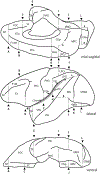MRI-based Parcellation and Morphometry of the Individual Rhesus Monkey Brain: the macaque Harvard-Oxford Atlas (mHOA), a translational system referencing a standardized ontology
- PMID: 32960419
- PMCID: PMC8608281
- DOI: 10.1007/s11682-020-00357-9
MRI-based Parcellation and Morphometry of the Individual Rhesus Monkey Brain: the macaque Harvard-Oxford Atlas (mHOA), a translational system referencing a standardized ontology
Abstract
Investigations of the rhesus monkey (Macaca mulatta) brain have shed light on the function and organization of the primate brain at a scale and resolution not yet possible in humans. A cornerstone of the linkage between non-human primate and human studies of the brain is magnetic resonance imaging, which allows for an association to be made between the detailed structural and physiological analysis of the non-human primate and that of the human brain. To further this end, we present a novel parcellation method and system for the rhesus monkey brain, referred to as the macaque Harvard-Oxford Atlas (mHOA), which is based on the human Harvard-Oxford Atlas (HOA) and grounded in an ontological and taxonomic framework. Consistent anatomical features were used to delimit and parcellate brain regions in the macaque, which were then categorized according to functional systems. This system of parcellation will be expanded with advances in technology and, like the HOA, will provide a framework upon which the results from other experimental studies (e.g., functional magnetic resonance imaging (fMRI), physiology, connectivity, graph theory) can be interpreted.
Keywords: HOA; MRI; Ontology; cortical parcellation; mHOA; macaque monkey.
© 2020. Springer Science+Business Media, LLC, part of Springer Nature.
Figures









Similar articles
-
HOA2.0-ComPaRe: A next generation Harvard-Oxford Atlas comparative parcellation reasoning method for human and macaque individual brain parcellation and atlases of the cerebral cortex.Front Neuroanat. 2022 Nov 10;16:1035420. doi: 10.3389/fnana.2022.1035420. eCollection 2022. Front Neuroanat. 2022. PMID: 36439195 Free PMC article.
-
Macaque Brainnetome Atlas: A multifaceted brain map with parcellation, connection, and histology.Sci Bull (Beijing). 2024 Jul 30;69(14):2241-2259. doi: 10.1016/j.scib.2024.03.031. Epub 2024 Mar 15. Sci Bull (Beijing). 2024. PMID: 38580551
-
The Subcortical Atlas of the Rhesus Macaque (SARM) for neuroimaging.Neuroimage. 2021 Jul 15;235:117996. doi: 10.1016/j.neuroimage.2021.117996. Epub 2021 Mar 29. Neuroimage. 2021. PMID: 33794360
-
Parcellation of Macaque Cortex with Anatomical Connectivity Profiles.Brain Topogr. 2018 Mar;31(2):161-173. doi: 10.1007/s10548-017-0576-9. Epub 2017 Jul 13. Brain Topogr. 2018. PMID: 28707157
-
The prefrontal cortex: comparative architectonic organization in the human and the macaque monkey brains.Cortex. 2012 Jan;48(1):46-57. doi: 10.1016/j.cortex.2011.07.002. Epub 2011 Jul 29. Cortex. 2012. PMID: 21872854 Review.
Cited by
-
Mapping sagittal-plane reference brain atlas of the cynomolgus macaque (Macaca fascicularis) based on consecutive cytoarchitectonic images.Brain Struct Funct. 2024 Nov;229(8):2045-2057. doi: 10.1007/s00429-024-02851-y. Epub 2024 Aug 27. Brain Struct Funct. 2024. PMID: 39192084 Free PMC article.
-
Anatomically curated segmentation of human subcortical structures in high resolution magnetic resonance imaging: An open science approach.Front Neuroanat. 2022 Sep 30;16:894606. doi: 10.3389/fnana.2022.894606. eCollection 2022. Front Neuroanat. 2022. PMID: 36249866 Free PMC article.
-
A Proposed Human Structural Brain Connectivity Matrix in the Center for Morphometric Analysis Harvard-Oxford Atlas Framework: A Historical Perspective and Future Direction for Enhancing the Precision of Human Structural Connectivity with a Novel Neuroanatomical Typology.Dev Neurosci. 2023;45(4):161-180. doi: 10.1159/000530358. Epub 2023 Mar 28. Dev Neurosci. 2023. PMID: 36977393 Free PMC article.
-
Human Alzheimer's Disease ATN/ABC Staging Applied to Aging Rhesus Macaque Brains: Association With Cognition and MRI-Based Regional Gray Matter Volume.J Comp Neurol. 2024 Sep;532(9):e25670. doi: 10.1002/cne.25670. J Comp Neurol. 2024. PMID: 39315417 Free PMC article.
-
A proposed structural connectivity matrices approach for the superior fronto-occipital fascicle in the Harvard-Oxford Atlas comparative framework following the Pandya comparative extrapolation principle.J Comp Neurol. 2023 Dec;531(18):2172-2184. doi: 10.1002/cne.25562. Epub 2023 Nov 27. J Comp Neurol. 2023. PMID: 38010231 Free PMC article.
References
MeSH terms
Grants and funding
LinkOut - more resources
Full Text Sources
Medical

